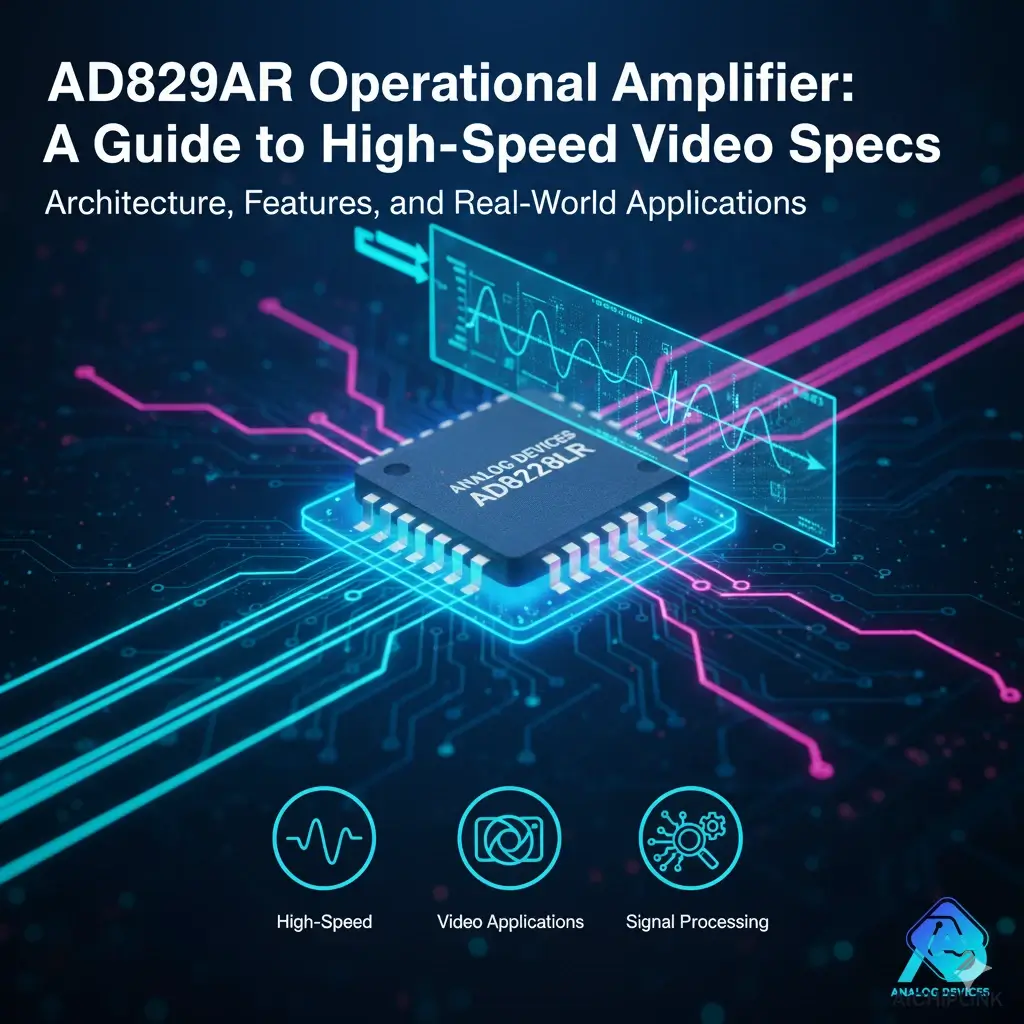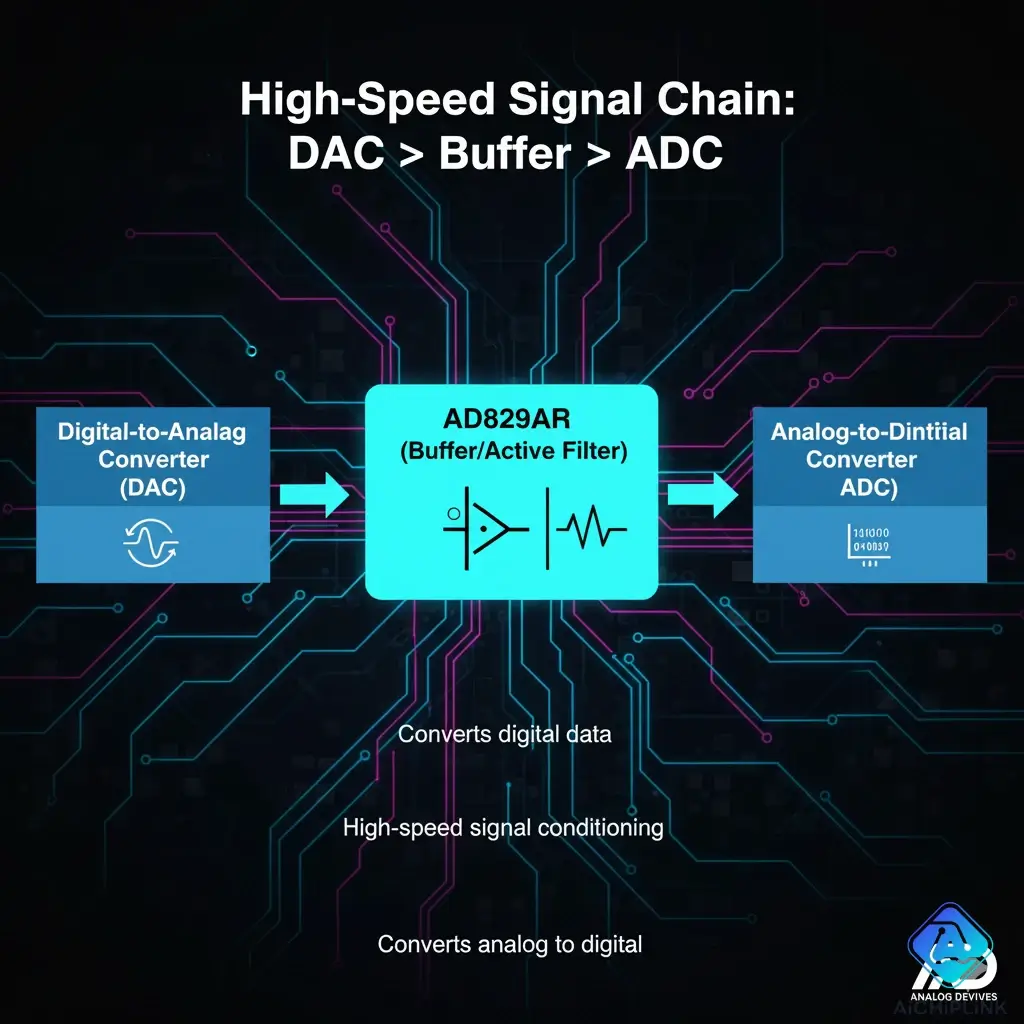
Table of Contents
- 1.0 What is the AD829AR Operational Amplifier?
- 1.1 The High-Speed, Low-Noise Video Specialist
- 1.2 Decoding the Part Number: AD829AR
- 1.3 Key Features from the Datasheet
- 2.0 AD829AR Key Technical Specifications (Datasheet Deep-Dive)
- 2.1 Core Performance Specs (Slew Rate, Bandwidth)
- 2.2 Understanding its Video Capabilities
- 2.3 AD829AR vs. AD811: A Quick Comparison
- 3.0 AD829AR Pinout (SOIC-8 Package)
- 3.1 8-Lead SOIC Pin Configuration
- 3.2 Pin Functions Explained
- 4.0 AD829AR Applications and Design Guide
- 4.1 Common Applications (ADC Drivers, Filters)
- 4.2 How to Use the AD829AR: Basic Video Buffer Circuit
- 4.3 Finding an AD829AR Equivalent or Replacement
- 5.0 Frequently Asked Questions (FAQ)
If you've ever tried to amplify a high-frequency video signal or buffer the input to a high-speed ADC, you've probably run into a frustrating problem. Your standard, everyday op-amp (like the LM741 or even a TL072) just can't keep up. The signal comes out looking distorted, with rounded edges and attenuated highs. This is where a high-speed specialist like the AD829AR Operational Amplifier comes in.
This isn't your beginner's op-amp. It's a high-performance analog component designed specifically for the demanding world of video and high-speed signal processing. In fact, the global market for high-speed op-amps is projected to see significant growth, reaching well into the billions by 2030, driven by the needs of 5G, data acquisition, and professional video. The AD829 is a classic part that set the stage for this technology.
This guide will serve as your technical deep-dive into the AD829AR datasheet, explaining its core specifications, pinout, and the critical applications that make it a go-to part for analog engineers.
1.0 What is the AD829AR Operational Amplifier?
The AD829AR is a high-speed, low-noise, single-channel operational amplifier developed by Analog Devices. It was designed to excel in one key area: driving heavy capacitive loads (like coaxial cables) at very high frequencies without losing signal integrity.
Think of it as the sports car of op-amps. A standard op-amp is a reliable family sedan—it gets the job done for everyday DC and audio signals. The AD829 is a Formula 1 car—it's purpose-built for speed.
1.1 The High-Speed, Low-Noise Video Specialist
The AD829AR's design is a blend of impressive specifications that make it ideal for video: * **High **slew rate**:** It can change its output voltage incredibly quickly, which is necessary to reproduce the sharp, vertical edges of a video signal. * **Wide Bandwidth:** It can amplify a wide range of frequencies (from DC up to many megahertz) with consistent gain. * **Low Noise:** It introduces very little of its own "hiss" or noise, ensuring the output signal is a clean copy of the input. * **High Output Drive:** It can supply a large amount of current (up to 50 mA) to drive difficult loads like a 75Ω terminated coaxial cable.1.2 Decoding the Part Number: AD829AR
As an engineer, you know the part number is a code. Here’s the key: * **AD829:** This is the base product name. * **A:** This is the **grade**. 'A' grade typically denotes a tighter specification (e.g., lower offset voltage) than a 'J' grade. * **R:** This specifies the **package type**, which is an **8-lead SOIC** (Small-Outline Integrated Circuit). You may also see the "J" suffix, which denotes a PDIP package.1.3 Key Features from the Datasheet
When you first open the **AD829AR datasheet**, these are the highlights you'll see: * **High Slew Rate:** 230 V/µs * **Wide Bandwidth (Small Signal):** 750 MHz * **Low Noise:** 10 nV/√Hz * **High Output Current:** 50 mA * **Low Distortion:** -79 dBc at 1 MHz * **Single Supply Capability:** Can operate from a single +5V supply or dual supplies (e.g., ±5V).2.0 AD829AR Key Technical Specifications (Datasheet Deep-Dive)
The performance of an op-amp is defined by its specs. Here’s what makes the AD829AR a high-speed part.
2.1 Core Performance Specs (Slew Rate, Bandwidth)
| Parameter | Value | What it Means |
|---|---|---|
| Gain Bandwidth Product (GBP) | 750 MHz | Allows for high gain at high frequencies (e.g., a gain of 10 up to 75 MHz). |
| Slew Rate | 230 V/µs | This is the key spec. It can swing its output by 230 volts in one microsecond, ensuring sharp signal edges. |
| Settling Time (to 0.1%) | 45 ns | How quickly the output settles to its final value after a step input. Vital for ADC drivers. |
| Output Current | ±50 mA | Can easily drive 75Ω and 150Ω loads (like standard video cables). |
| Input Voltage Noise | 10 nV/√Hz | Respectably low noise, ensuring signal clarity. |
| Supply Voltage Range | +5V to ±15V | Highly flexible, can be used in 5V digital systems or ±12V analog designs. |
2.2 Understanding its Video Capabilities
When the datasheet says "video amplifier," it's referring to specific specs. * **0.1 dB Gain Flatness:** 30 MHz. This means the gain is exceptionally flat across the entire NTSC/PAL video broadcast band, so no part of the picture (e.g., color vs. brightness) is amplified more than another. * **Differential Gain Error:** 0.02%. This measures how much the *color* gain changes as the *brightness* of the picture changes. A low value is critical for a stable, high-quality image. * **Differential Phase Error:** 0.04°. This measures how much the *color hue* shifts as the *brightness* changes.2.3 AD829AR vs. AD811: A Quick Comparison
The AD829 is often compared to its cousin, the **AD811**, another classic video op-amp. While both are high-speed, they are optimized for different things."The AD829 is your load-driving workhorse, a power-hitter. The AD811 is your ultra-low-noise specialist, a precision surgeon. You choose the AD829 to drive a cable; you choose the AD811 to condition a tiny signal before the driver."
| Feature | AD829AR (The Driver) | AD811 (The Low-Noise Preamp) |
|---|---|---|
| Slew Rate | 230 V/µs | 2500 V/µs |
| Input Voltage Noise | 10 nV/√Hz | 1.9 nV/√Hz (Ultra-Low) |
| Output Current | ±50 mA | ±50 mA |
| Primary Use | Video Line Driver, ADC Driver | Ultra-Low Noise Preamp, IF/RF Amplifier |
3.0 AD829AR Pinout (SOIC-8 Package)
The AD829AR comes in a standard 8-pin SOIC package, making it easy to integrate into modern surface-mount designs.
3.1 8-Lead SOIC Pin Configuration

3.2 Pin Functions Explained
| Pin | Name | Function |
|---|---|---|
| 1 | NC | No Connect. (This pin is not used). |
| 2 | V- | Inverting Input |
| 3 | V+ | Non-Inverting Input |
| 4 | V- | Negative Power Supply |
| 5 | NC | No Connect. |
| 6 | VOUT | Output |
| 7 | V+ | Positive Power Supply |
| 8 | NC | No Connect. |
Important Design Note: Notice that there are three "No Connect" (NC) pins. These pins are not connected to the chip's die internally. You should typically connect them to your ground plane to act as small heatsinks and to provide mechanical stability.
4.0 AD829AR Applications and Design Guide
You wouldn't use this chip to build a simple LED flasher. You use the AD829AR when speed and power are non-negotiable.
4.1 Common Applications (ADC Drivers, Filters)
* **Video Line Driver:** Its primary application. It can easily drive a 75Ω coaxial cable with a clean video signal. * **ADC Driver:** High-speed Analog-to-Digital Converters (ADCs) have "switched capacitor" inputs that require a high-current, fast-settling buffer. The AD829 is a perfect driver. * **High-Speed Active Filters:** Building active low-pass or high-pass filters for anti-aliasing or signal reconstruction at frequencies in the MHz range. * **Professional Video Equipment:** Used in video switchers, distribution amplifiers, and cameras. * **High-Speed Data Acquisition Systems:** Buffering the output of a DAC or the input of an ADC.
4.2 How to Use the AD829AR: Basic Video Buffer Circuit
Let's build the most common circuit: a unity-gain buffer (voltage follower) to drive a 75Ω video cable.- Power: Connect Pin 7 to your positive supply (e.g., +5V) and Pin 4 to your negative supply (e.g., -5V).
- Bypass (Critical!): Connect 0.1µF ceramic capacitors from Pin 7 to Ground and Pin 4 to Ground. Place them as physically close to the pins as possible. This is mandatory for high-speed stability.
- Input: Connect your video source (e.g., from a DAC) to the non-inverting input, Pin 3.
- Feedback Loop: Connect the output, Pin 6, directly to the inverting input, Pin 2. This sets the gain to 1 (unity-gain).
- Output: Connect Pin 6 to your 75Ω coaxial cable.
The principles shown here for layout and bypassing are essential for making the AD829AR work correctly.
4.3 Finding an AD829AR Equivalent or Replacement
The AD829 is a classic. If you're repairing old equipment, you'll want a direct **AD829AR replacement**. If you are designing a new board and need a modern equivalent, you are looking for a "high-speed, load-driving op-amp." * **AD811:** A common alternative, but optimized for ultra-low noise, not load driving. * **AD8051:** Another popular high-speed op-amp from ADI. * **THS40xx Series (TI):** Texas Instruments has a wide range of competing high-speed op-amps.When looking for an equivalent, you must compare the Slew Rate, Gain Bandwidth Product, and Output Current Drive.
Conclusion: A High-Speed Analog Workhorse
The AD829AR Operational Amplifier is a classic, high-performance component that solves a very specific problem: amplifying and driving high-speed signals without distortion. While it may be a mature part, its specifications are still impressive and it remains a critical component for maintaining a vast range of video, medical, and test equipment. Its combination of a high slew rate and high output current drive is what sets it apart as a true video specialist.
As high-speed data conversion and analog signal processing become even more critical in our connected world, the fundamental principles pioneered by chips like the AD829 will continue to be the foundation of all new designs.
If you are repairing a high-performance system or building a new design that demands speed and power, the AD829 is a proven solution. Find this part and other high-performance operational amplifiers in our extensive catalog at AichipLink today.
Frequently Asked Questions
What is the AD829AR op-amp?
The **AD829AR** is a high-speed, low-noise operational amplifier from Analog Devices, specifically designed for video applications. It features a very high slew rate (230 V/µs) and wide bandwidth (750 MHz). The 'AR' suffix indicates an 8-lead SOIC package and a commercial temperature range.
What is the AD829AR used for?
The AD829AR is primarily used as a **video line driver**, an **ADC (Analog-to-Digital Converter) driver**, in high-speed active filters, and as a signal processing buffer. Its ability to drive high-capacitance loads (like coaxial cables) makes it ideal for professional video and data acquisition.
What is the difference between the AD829 and AD811?
Both are high-speed op-amps from Analog Devices. The **AD829** is optimized for **driving heavy loads** (like 75Ω cables) with high current. The **AD811** is optimized for **ultra-low noise** (1.9 nV/√Hz) and is better for pre-amplifying very small, high-frequency signals.
Can I use the AD829AR on a single +5V supply?
Yes. The AD829AR is specified for operation from a single +5V supply or dual supplies up to ±15V. This makes it versatile for both modern 5V-only systems and older analog designs that use ±12V or ±15V rails.
Why are there "No Connect" (NC) pins on the AD829AR?
The 8-pin SOIC package is a standard, but the AD829's single-amplifier design only requires 5 pins (V+, V-, Vin+, Vin-, Vout). The other 3 pins are not connected to the internal die. In high-speed layouts, it is good practice to solder these NC pins to the ground plane to act as a heat sink and improve RF grounding.